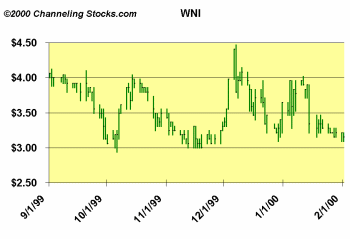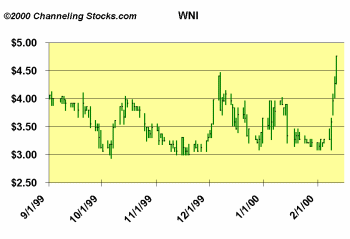Basic Concepts – Trading Stocks
The Philosophy of Channeling Stocks
These examples are from more than 20 years ago and it still works the same.
Channeling Stocks have a very clear and identifiable historical pattern. Stocks that Channel up and down in repeated waves. Notice in the example how the price Channels from $3.25 to $4.10 per share. Where would you think the price is going next?

These waves may become predictable. If you answered that the price is probably going to go up, you understand the very basic strategy of Channeling Stocks. Look at the chart below and see what actually happened to the price of WNI when we add another 8 days worth of data.

In addition, a line can be drawn across the peak and along the bottom. The area between these two lines is called the channel. The upper line is commonly referred to as the resistance level and the lower line is referred to as the support level. It is in this area that you will want to buy and sell your stock. Selling your stocks is the key. When investing in the stock market, it is not when you buy that counts it’s when you sell. You should know when you are going to sell your stock before you even buy them. Knowing when you are going to sell before you buy the stocks helps eliminate the emotional factors of fear or greed that sometimes push or pull individual investors. As you become more familiar with Channeling Stocks.com, we are confident the nervousness of being an investor will subside.
Do The Math – Investing in Stocks


The following is a true life example of how one could have profited using the Channeling Stocks.com concepts. Our example will not include any commission amounts as they vary from broker to broker. Also, while we have rounded all the numbers off, it will not interfere with the actual results. We will also be referencing something called a GTC (Good ‘Til Canceled). A GTC order is an order placed by an investor that instructs the broker that the order shall remain in effect until it is filled (either bought or sold at a predetermined price), or canceled by the investor. Annual percentage returns figures will be further defined when you get to the Practice Trading page.
In less than 6 months you could have bought and sold shares of a company with the symbol WNI on 4 different occasions. Each time you bought and sold this stock you would have taken in a profit of 50 cents per share. WNI had established a support level of $3.25 and a resistance level of $4.10. So your buying price in this stock would be set at $3.50 and your selling price would be at $4.00. As you can see, you are not going to be buying at the lowest possible price nor will you be selling at the highest possible price. The reason for this is simple. When you buy into a Channeling Stock, you will always want to insure that the price has reached the lowest level and has now begun its channel back up. There is no way to determine the absolute bottom until you see it going back up. The same holds true for the highest possible price but you have already addressed this by knowing when you were going to sell the stock prior to even buying it. There is more in-depth detail regarding this on our Advanced Concepts page.

Find out which stocks are trading in the Channel!
Channel 1
Back to the real life example. Let’s say you purchased $2,000 worth of WNI stock for $3.50 per share on Dec. 31, 1999. That would have given you ownership of 571 shares. You then would immediately put in your GTC, (sell order at predetermined price), to sell those shares at $4 per share. On January 11, 2000 the stock price reaches $4 and your GTC would have triggered the sale of your 571 shares for a 50 cent profit per share.
So your $4 sell price, less your $3.50 buy price, gave you a profit of .50 cents per share. You originally bought 571 shares with your $2,000 investment. You would then multiply the profit you made on each share of .50 cents by 571 to see that you made $285.50 on the transaction. If you divide the $285.50 into the original $2000 initial investment total, you see that you received a 14% return. The total time it took for you to get this 14% return was twelve days.
Channel 2
By adding your profit to the original investment amount, you now $2,285.50 to purchase this stock again. On Feb. 8, 2000 you could have purchased 653 shares at $3.50 and again set your GTC to sell the stock at $4.00. On Feb. 9, 2000 the stock again reached $4 and your GTC again sold your shares for a .50 cent profit per share. (Note – the chart above has the incorrect sell date of 2/8 on it. It should read 2/9 instead.)
Now you have made .50 cents a share but this time it was for 653 shares which gave you a profit of $326.50 in just 1 day! Dividing your profit of $326.50 into your $2,285.50 investment again gives you another 14% return on your money. But you’re not done yet.
Channel 3
By adding the profit of $326.50 to the invested amount of $2,285.50, you now have $2,612 to purchase 746 shares at $3.50 when then stock channels back to $3.50 per share on March 24, 2000. By now you know that you have your sell order, (GTC), in at $4 once you purchase the stock. On April 11, 2000 the stock reached $4 which triggered the sale of your shares again.
By multiplying the .50 cent per share profit by the 746 shares you bought, you have just added another $373 in profit to your portfolio. Another 14% return. Your original $2,000 investment is now worth $2,985 after you add up all the profits. But you are not done yet !
Channel 4
Now you have $2,985 to purchase 852 shares at $3.50, which you do on April 20, 2000. Your GTC (sell order) set at $4 triggers on May 4, 2000 and you again sold your shares for a .50 cent profit per share. You just added another $426 (14%) to your bank account.
All told, your initial $2,000 investment has grown to $3,411 over a five month time frame.
Congratulations!
…you have just made a 70% annualized return on your money in just over 5 months! The reason why the annualized total is only 70% is because of the time that passed while you waited for WNI to channel back down to $3.50 after your sold it for a profit. It is during this “down time” that you should be looking at other Channeling Stocks to invest in and diversify your money. That is why Channeling Stocks.com provides our members with a weekly updated list of stocks that are Channeling.
Find out which stocks are trading in the Channel!
We continually search for lower priced Channeling Stocks because they allow more investors to get involved. We would rather be able to purchase 1000 shares of a stock that Channels between $4 and $5 per share than the stocks that Channel between $20 and $24 per share. The reason is simple. We can buy more shares at $4 than at $20.
AMOUNT INVESTED SHARE PRICE # of shares
| $1000 Divided by: | $4 per Share | = 250 Shares vs |
| $1000 Divided by: | $20 per Share | = 50 Shares |
For the sake of example, let’s assume both stocks increase in price by $1 per share. If you had invested $1,000 in the $4 stock, you would have just made $250 because each share is worth $1 more and you were able to buy 250 shares. If the $20 stock also rose $1 in price you would have only made $50 because you could only buy 50 shares for your $1,000 investment. Channeling Stocks have no price boundaries. At Channeling Stocks.com we will find them for you at all levels.
At Channeling Stocks.com our efforts are concentrated on identifying Channeling Stocks that trade more than 50,000 shares per day. In doing so, we reduce the possibility of manipulation of prices. Thinly traded stocks, less than 50,000 shares, often will have wide bid (how much you are willing to pay) and ask (how much the seller wants to charge you) prices that threaten your profit. Our experience in researching and investing in Channeling Stocks.com, takes all of this into account for you prior to posting our weekly selections.
